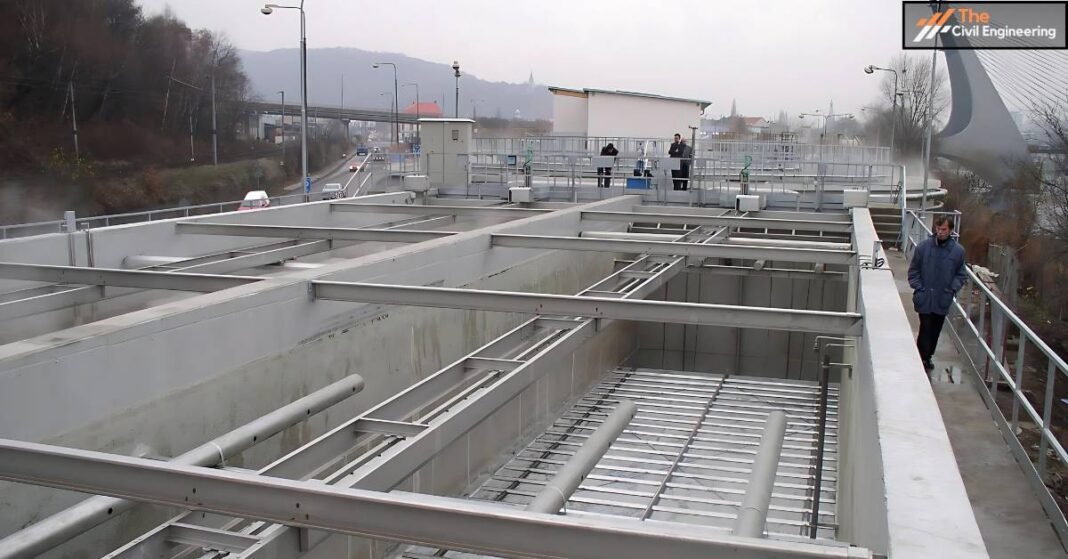In this article, we will discuss the sedimentation tank numerical.
1. Formula
| Vs = g(S-1) d2/ 18γ ——-(i) |
Where,
γ = Dynamic Viscosity
S = Specific gravity of the particle
d = Diameter of Particle
Vs = Settling Velocity
Temperature effect on settlement
Kinematic viscosity depends on temperature and the settling of particles is directly affected by the temperature. The settling velocity of a particle will be increased with an increase in temperature so that kinematic viscosity decreases in the increase in temperature. Stokes equation can be expressed by introducing temperature instate of kinematic viscosity as indicated below.
| Vs = 418 (S-1) d2 (3T +70)/100 |
Where,
Vs is the settling velocity of a particle in mm/sec
d is the diameter of a particle in mm
T is the temperature of water in °C
S is the specific gravity of the particle
Again, for particles of diameter greater than 1 mm and Re 1000 to 10000 the nature of settling of the particle is turbulent and settling is turbulent settling.
The drag coefficient for the settling CD = 0.4, putting the value in equations (i) we get,
Vs= √3.33gd(S-1) ……. .called Newton’s equation.
Equations for Settling Velocity of Discrete Particles
| S.No | Law and Equation | Re | Particle size in mm |
| 1. | Stoke’s (Laminar)Vs = g(S-1) d2/ 18γ | Upto 1 | Up to 0.1 |
| 2. | Hazen’s (Transition)Vs =√4gd(S-1)/3Cd
Cd = 24/Re + 3/√Re + 0.34 |
>1 to 1000 | >0.1 to 1 |
| 3. | Newton’s (Turbulent)Vs= √3.33gd(S-1) | >103 to 104 | Greater than 1 |
| % settled = (Vs / overflow rate) x 100 |
2. Sedimentation Tank Numerical
Find the settling velocity of a paricle in water under the given condition; diameter of pasrticle= 0.06 mm, specific gravity of particle = 2.6, temperature of water = 25ºC, kinematic viscosity at 25ºC = 0.897 centistokes.
Solution
Using Stokes equation
Vs = g(S-1) d2/ 18γ
Vs = 9810x (2.65-1) x 0.062/(18×0.897)
Therefore; Vs= 3.609 mm/sec
Check:
Reynolds number
Re = Vs x d/ γ
Re= 3.609 x 0.06/ 0.897
Re= 0.241 < 1
Hence stokes law is applicable.
Alternatively the problem can be solved by usingn equation;
Vs = 418 (S-1) d2 (3T +70)/100
Vs= 418 (2.65-1) x 0.062 x (3×25+70)/100
Vs= 3.60 mm/sec
3. Find the settling velocity of a particle in water under the given condition; diameter of particle = 6 mm, the specific gravity of particle = 2.65, the temperature of water =25 °C, kinematic viscosity at 25 °C = 0.897 centistokes.
Solution:
Using Newton’s equation;
Vs =√3.33gd(S-1)
Vs = √3.33x9810x6x(2.65-1)
Therefore; vs = 568.68 mm/sec
Check:
Reynolds number Re = vd/γ
= 568.68×6 /0.897
= 3804 which is between 103 to 104
Hence Newton’s law is applicable.
4. In a continuous flow settling tank 3 m deep and 60 m long, what flow velocity of water would be required for effective removal of 0.025 mm particles at 25 °C. The specific gravity of particles is 2.65 and kinematic viscosity at 25 °C 0.897 centistokes.
Solution:
Since the diameter of the particle is less than 0.1 mm, Stoke’s law will be applicable.
Using Stoke’s equation;
Vs = g(S-1) d2/ 18γ
Vs = 9810 mm/sec (2.65 —1)x 0.0252/ (18 x 0.897 mm2 /sec)
Therefore; Vs = 0.626 mm/sec
Reynolds number Re= vd/γ
= (0.626 x 0.025 )/ 0.897
= 0.017 < 1
Hence Stoke’s law is applicable.
Now using relation,
V/Vs=L/H
V= 0.626 x 60/3
V= 12.52 mm/sec
Thus in order to ensure effective removal of particles finer than 0.025 mm size the flow velocity in the settling tank should not be more than 12.52 mm/sec.
5. Find the diameter of the particles with specific gravity 1.4 removed in a tank having a surface area of 250 m2 and treating 10 MLD of water. The temperature of the water is 22 °C.
Solution:
Surface overflow rate= Q/A
= 10 x 106 lit/day / 250 m2
= 40 m3/m2/day
In a tank, when the settling velocity of a particle is greater than SOR; all particles will be removed, and when Vs is equal to SOR Particles will drop at the end of the tank. Thus minimum settling velocity required for the particles to settle should be equal to SOR = 40 m3/m2/day.
= 40x 1000 / 24 x 60 x 60
= 0.463 mm/sec
Now,
Vs = 418 (S -1)d2 (3T+70)/100
3 x 22 + 70)
0.463= 418x(1.4-1)xd2x(3 x 22 + 70)/100
d = 0.045 mm
6. A sedimentation tank is designed for an overflow rate of 5000 m2 liters per m2 per hour. What percentage of particles of diameter (a) 0.05 mm and (b) 0.025 mm will be removed in this tank? The temperature of the water is 20 °C and the specific gravity of particles is 2.65.
Solution:
Surface overflow rate = 5000 litres/m2/hr
= 5000 / 1000 m3/m2/hr
= 5 x 1000 / 60 x 60
=1.39 mm/sec
(a) The settling velocity of particle of diameter 0.05 mm
Vs = 418 (S -1) d2 (3T + 70)/100
Now,
vs = 418x (2.65-1)x 0.052 x (3×20+70) /100
vs = 2.242 mm/sec
% settled = (Vs / overflow rate) x 100
= 2.242/1.39 x100
= 162%> 100%
Hence all the particles of diameter 0.05mm will settle down.
b. The settling velocity of a particle of diameter 0.025 mm.
Vs = 418 x (2.65 -1)x 0.0252 x(3x 21+70 )/100
Vs = 0.56 mm/sec
Now,
% settled = (Vs/ SOR) x100
= (0.56 / 1.39)x 100
= 40.28 %
Hence 40.28 % of the particles of diameter 0.05 mm will settle down.
| Read Also: Hardness and Alkalinity Numerical | Water Supply Engineering |
7. A rectangular sedimentation tank is to treat 10 MLD of water. detention basin of width to length ratio of one third is proposed to trap all particles larger than 0.04 mm in size. Assuming a specific gravity of. 2.65 for the particles and temperature of the water is 20°C, compute the basin dimensions. If the depth of the tank is 33 m, calculate the detention period.
Flow (Q) = 10 MLD = 10 x 106 lit/day
= 0.11574 m3/sec
The settling velocity of particle of diameter 0.04 mm
Vs = 418 (S -1) d2 (3T + 70)/100
Vs = 418x (2.65-1) x 0.042 i3x 20+ 70 x)/100
vs =1.4345 mm/sec
In a tank, when the settling velocity of a particle is greater than SOR. all particles will be removed and when V is equal to soli particles will drop at the end of the tank. Thus minimum settling velocity required for the particles to settle should be equal to SOR.
Therefore; vs = SOR = 1.4345 mm/sec
SOR = Q/BL
or, 1.4345 x10-3 = 0.11574/BL
BL = 80.678
B/L = 1 / 3
Breadth (B) = 5.2 m
Length (L) = 15.6 m
Height (H) = 3.5 m
Therefore volume (LBH) of a rectangular basin = 283.92 m3
Detention period (t)= LBH/Q
= 283.92/0.11574
= 40.88 minutes
= 0.68 hours
| Read Also: Quantity of Water Numerical |
8. An old tank having a dimension of 12m x 5m x 3m is available in a village. It is proposed to use as a settling tank. At least 95% of particles having a diameter of 0.025 mm, specific gravity of 2.65 is expected to remove on that tank at 20 °C. What will be an overflow rate on using that tank?
Dose tank dimension is enough 99 % of particles having diameter 0.04 mm at same to conditions?
Solution:
The settling velocity of particle of diameter 0.025 mm
Vs = 418 (S -1) d2 (3T + 70)/100
Now,
Vs = 418 x (2.65-1)x 0.0252 x (3 x 20 + 70) 100
Vs = 0.56 mm/sec
% settled = (Vs / Overflow rate) x 100
or, 95 = (0.56/Overflow rate) x 100
Therefore overflow rate 0.589 mm /sec = 50.96 m3/m2/day
Again,
The settling velocity of particle of diameter 0.04 mm
Vs = 418 (S -1) d2 (3T + 70)/100
Vs= 418x(2.65-1)x 0.042 (3×20+70) x 100
Vs= 1.4345 mm/sec
Now,
% settled = (Vs/ overflow rate) x100
% settled = (1.434/0.589) x100
= 243% >100%
Hence the tank dimension is enough to remove 99% of particles, having a diameter of 0.04 mm at the same conditions.

